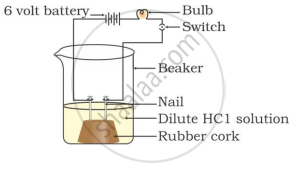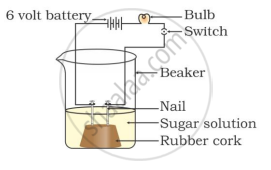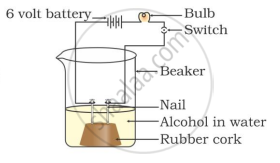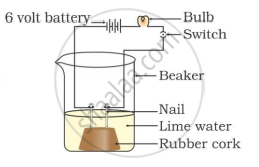Advertisements
Advertisements
प्रश्न
Why does distilled water not conduct electricity, whereas rain water does?
उत्तर १
Distilled water cannot conduct electricity because it does not contain ions, while rainwater conducts electricity because it contains ions due to the presence of dissolved salts in it.
उत्तर २
- Distilled water does not contain any ionic compounds in it.
- Whereas rainwater has a lot, more compounds.
- Rainwater has dissolved acidic gases, such as carbon dioxide, from the air, and that forms carbonic acid. This means that it has hydrogen ions and carbonate ions. Therefore, in the presence of acids, rainwater can conduct electricity.
APPEARS IN
संबंधित प्रश्न
Lime water turns milky when __________ gas is passed through it.
(a) H2
(b) CO
(c) CO2
(d) SO2
What colour do the following indicators turn when added to a base or alkali (such as sodium hydroxide)?
(a) methyl orange
What colour do the following indicators turn when added to a base or alkali (such as sodium hydroxide)?
red cabbage extract
What colours do the following indicators turn when added to an acid (such as hydrochloric acid)?
methyl orange
Fill in the blank in the following sentences:
Acids produce.......................... ions on dissolving in water.
What happens when dilute hydrochloric acid is added to sodium carbonate? Write a balanced chemical equation of the reaction involved.
Explain with an example. Give the chemical equation of the reaction which takes place.
10 mL of a solution of NaOH is found to be completely neutralised by 8 mL of a given solution of HCl. If we take 20 mL of the same solution of NaOH, the amount of HCl solution (the same solution as before) required to neutralise it will be:
(a) 4 mL
(b) 8 mL
(c) 12 mL
(d) 16 mL
What is common in all the water soluble bases (or alkalis)?
What happens when carbon dioxide gas is passed through lime water for a considerable time ?
Write equations of the reactions involved.
Write the main difference between an acid and a base.
Choose the correct option from given alternative:
When a small amount of acid is added to water, the phenomena which occur are:
(A) Dilution
(B) Neutralization
(C) Formation of H3O+ ions
(D) Salt formation
In the experimental set-up to show that "the germinating seeds give out carbon dioxide", answer the following questions:
(i) Why do we keep the conical flask airtight?
(ii) Name the substance kept in the small test tube inside the conical flask. Write its role.
(iii) Why does water rise in the delivery tube?
Vinay observed that the stain of curry on a white shirt becomes reddish-brown when soap is scrubbed on it, but it turns yellow again when the shirt is washed with plenty of water. What might be the reason for his observation?
- Soap is acidic in nature
- Soap is basic in nature
- Turmeric is a natural indicator which gives reddish tinge in bases
- Turmeric is a natural indicator which gives reddish tinge in acids
In which of the following setups would the bulb glow?
Which of the following phenomena occur when a small amount of acid is added to water?
- Ionisation
- Neutralisation
- Dilution
- Salt formation
A metal carbonate X on reacting with an acid gives a gas which when passed through a solution Y gives the carbonate back. On the other hand, a gas G that is obtained at anode during electrolysis of brine is passed on dry Y, It gives a compound Z, used for disinfecting drinking water. Identity X, Y, G and Z.




